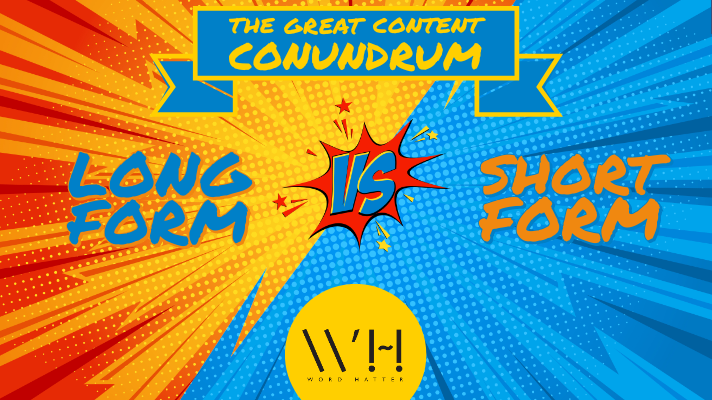Long, immersive reads you can cozy up to or short, ‘snacky’ articles to-go. Which kind do you prefer?
Say the words “long form content” or “short form content”, and you’ll have a chorus of voices that erupt in defence of both. Short form content is often dismissed as shallow and flighty, and long form derided as long and boring. But what does your audience want?
Would they prefer to stop for the quick, crispy bites of information you send out? Or would they slow down, and allow you to woo them over a luxurious 7-course meal?
Let’s start by defining long form and short form content. Definitions vary for both, and can depend on your reader’s preference. To some a 500-word content piece is a little too much information, for others it’s just not enough.
For all intents and purposes, we’re going to define them in the broadest sense, where long form is anything above 800 words, while short form can range between 50-500 words.
The ultimate decision, though, lies in the hands of your audience. An audience with varied tastes and differing perspectives. Masses of content come out every day – each looking for a little bit of valuable space in your customer’s mind. Busy lives make it harder for customers to find time to read and absorb the message.
So, in a time starved world, it may seem like the answer is pretty clear. Who has time to read 800 words (or more)?
But wait! Don’t write off long content as too tiring for your customers to read. Like we mentioned previously, customers are a lot more complex and require more than simple solutions. Content length is dependent on a variety of factors, including interest, education and what function the content can play for your product. So, let’s look at both sides of the content coin.
The Case for Long Form:
Long-form content includes blogs, case studies, white papers, e-books, long videos, articles, books, webinars.
There are numerous reasons to consider long-form content. Firstly, Google search engine rankings tend to place long-form content over short-form. The choice is entirely logical – if you had to rank a page where the customer spends 25 seconds over one where the customer will spend 4-5 minutes, which would you choose?
Secondly, long-form content is typically written to be informative and educational. They demonstrate a certain level of expertise and research that has gone into writing a piece. It provides the information to a highly invested audience. They want to know more about this topic. Therefore, with that level of interest, you can look to developing more long-lasting relationships with your customers.
Research also shows that long-form content is shared more frequently than short form pieces. So, with long-form content you have visibility (in the form of Google rankings and shares) as well as an aura of expertise and the research to back your message.
The Case for Short Form:
As we’ve mentioned earlier, short form content can range between a quick 50-100 words and go up to around 600 words. It is easily digestible, can be read quickly and doesn’t require too much critical thinking. The length of the content helps your audience become aware of the services/products that your company is offering. Short-form content can include status updates, short videos, infographics, tweets, blog posts and more.
Your content should contain one idea, that is easily explained. You don’t need to add too many elements, your audience will fill in the gaps for you (as long as the message is effectively communicated).
There is a trend towards short-form content, as these bite-sized pieces of content can slip through the clutter to reach an audience. Tiktok videos, Instagram stories, crisp infographics or even platforms like Pinterest hold their audience by presenting fun, eyes-on-the-eyes content.
Short-form content also suits many online users today, as most people tend to scan a piece of content, instead of reading it word for word. By using quick, short sentences, you can still deliver a strong message to your audience. Just because the content is smaller in size, doesn’t mean it can’t create a lasting impact. Finally, for those of us who do our reading on the go (on our phones) short-form content is ideal. It is definitely more mobile-friendly, giving it a much wider audience.
When it comes to this battle – which side are you on?
Or, more importantly, do you have to choose? Why not have the best of both worlds?
How to get started
To create effective content, you need to know your audience. Insight into what they would prefer can help structure what kind of pieces you need to write, what kind of information you need to provide and what kind of response you’re likely to garner with your content.
This requires a bit of research and data, which will help you create a content strategy that accounts for both long-form and short-form content. It can help decide what time and what context is right for either type of content. So, ideally, a mix of the two is the best approach. You can build a solid foundation for your long-form content, while employing the short, snackable content to draw in new customers and build interest for your brand/company/product/ service.
Short-form will bring in the audience, while long-form will help them stay invested and create long term relationships.
If you’re interested in creating a content strategy for your audience, Word Hatter can help!



